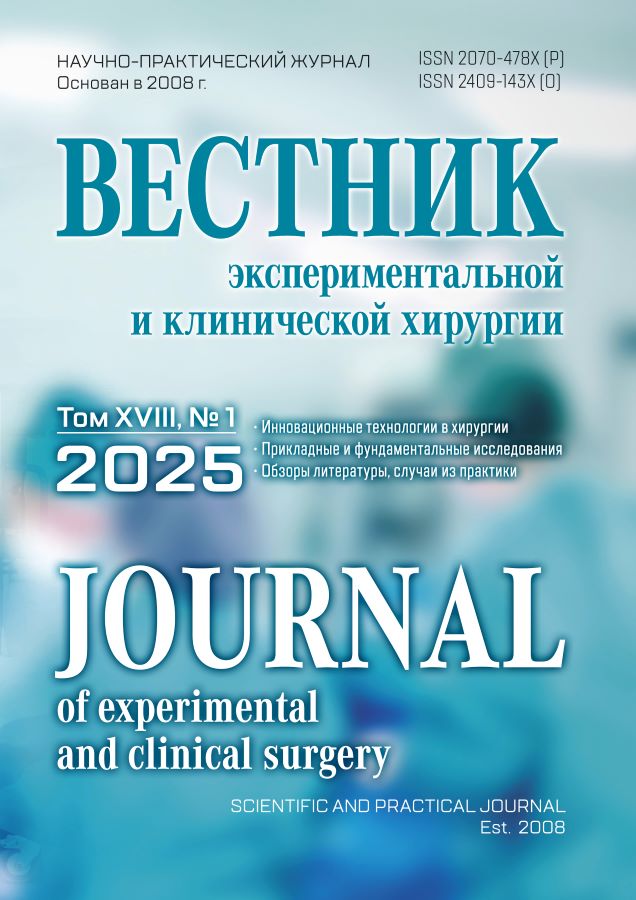Blunt liver trauma: from non-operative management to transplantation. Systematic review and meta-analysis. Part I: primary control point - mortality
- Authors: Aleksandrov V.V1, Maskin S.S.1, Matyukhin V.V.1, Korovin A.Y.2, Sigaev S.M.1, Biriulev D.S.3, Rachid A.1
-
Affiliations:
- Volgograd State Medical University
- Kuban State Medical University
- FSBEI HE VolgSMU MOH Russia
- Issue: Vol 18, No 1 (2025)
- Pages: 48-67
- Section: Review of literature
- URL: https://vestnik-surgery.com/journal/article/view/1825
- DOI: https://doi.org/10.18499/2070-478X-2025-18-1-48-67
- ID: 1825
Cite item
Abstract
Introduction. The high incidence of blunt liver injuries, general and postoperative mortality necessitate a search for optimal treatment options of the condition.
Аim. To conduct a systematic literature review and meta-analysis and compare various treatment options for patients with blunt liver injury.
Methods. A systematic search for non–randomized studies was conducted from 01 October 2015, a systematic search for randomized studies was conducted without time limits, until February 29, 2024.
Results. There is a clear trend towards non-surgical management of hemodynamically stable or stabilized patients, and in case of hemodynamic instability, the use of liver tamponade followed by angioembolization.
Conclusion. A larger number of well-planned randomized clinical trials are required to concretize the surgical approach to patients with liver injury.
Full Text
About the authors
Vasiliy V Aleksandrov
Volgograd State Medical University
Author for correspondence.
Email: 79178304989@yandex.ru
Ph.D., Docent, associate Professor of the Department of Hospital surgery
Russian Federation, VolgogradSergey S. Maskin
Volgograd State Medical University
Email: maskins@bk.ru
M.D., Professor, head of the Department of Hospital surgery
Russian Federation, VolgogradViktor V. Matyukhin
Volgograd State Medical University
Email: victor.matyukhin@gmail.com
Ph.D., Docent, associate Professor of the Department of Hospital surgery
Russian Federation, VolgogradAlexander Ya. Korovin
Kuban State Medical University
Email: kuman52@mail.ru
M.D., Professor, Professor of the Department of Faculty and Hospital Surgery
Russian Federation, KrasnodarSergey M. Sigaev
Volgograd State Medical University
Email: sersigaeff@yandex.ru
Applicant of the Department of Hospital surgery
Russian Federation, VolgogradDmitriy S. Biriulev
FSBEI HE VolgSMU MOH Russia
Email: Kotovo111083@yandex.ru
Applicant of the Department of Hospital surgery
Russian Federation, VolgogradAzad Rachid
Volgograd State Medical University
Email: azad92rasheed@gmail.com
Applicant of the Department of Hospital surgery
Russian Federation, VolgogradReferences
- Vladimirova ES, Valetova VV. Temporary hemostasis at severe hepatic injury and its influence on vital functions. Medical Alphabet. 2016; 3(20): 14-19. (in Russ.).
- Suvorov VV, Markevich VYu, Goncharov AV, Pichugin AA, Myasnikov NI, Petukhov KV, Kuraev PI, Nosov AM, Kaznacheev MV, Skakunova TYu. Differentiated surgical tactics for abdominal trauma, accompanied by damage to the liver and spleen. Military Medical Journal. 2021; 342(9):50-57. (in Russ.). https://doi.org/10.52424/00269050_2021_342_9_50
- Masljakov VV, Barsukov VG, Cherednik AA. Immediate results of treatment of closed liver injuries resulting from road traffic accidents. Bulletin of the medical Institute "REAVIZ": rehabilitation, doctor and health. 2016;4(24):45-51. (in Russ.).
- Afifi I, Abayazeed S, El-Menyar A, Abdelrahman H, Peralta R, Al-Thani H. Blunt liver trauma: a descriptive analysis from a level I trauma center. BMC Surg. 2018;18(1):42. PMID: 29914487; PMCID: PMC6006727. https://doi.org/10.1186/s12893-018-0369-4
- Reva VA, Samokhvalov IM, Golovko KP, Nosov AM, Demchenko KN, Petrov AN, Voronin SE, Mikulich AA, Zheleznyak IS, Denisov AV. Temporary endovascular prosthetics of the inferior vena cava in case of damage to its subhepatic segment is an innovative approach to the treatment of severe liver injuries. Military Medical Journal. 2021; 342(3):26-31. (in Russ.).
- Zargaran D, Zargaran A, Khan M. Systematic Review of the Management of Retro-Hepatic Inferior Vena Cava Injuries. Open Access Emerg Med. 2020;12:163-171. PMID: 32617024; PMCID: PMC7326178. https://doi.org/10.2147/OAEM.S247380
- Maskin SS, Ermolaeva NK, Aleksandrov VV, Matyukhin VV. Combined blunt abdominal injury: standardization of the therapeutic and diagnostic approach from the standpoint of evidence-based medicine: Monograph. Volgograd: Publishing House of VolgSMU, 2021. (In Russ.).
- Shapkin YuG, Chalyk YuV, Stekolnikov NYu, Kuzyaev TR. Packing in surgical treatment of severe liver damage. Polytrauma. 2020;1:18-22. (in Russ.). https://doi.org/10.24411/1819-1495-2020-10003
- Maskin SS, Aleksandrov VV, Matyukhin VV, Ermolaeva NK. Blunt liver injuries: the algorithm of surgeon's actions in a first-level trauma center. Polytrauma. 2020;2:84-91. (in Russ.). https://doi.org/10.24411/1819-1495-2020-10024
- Shchegolev AA, Al Sabunchi OA, Tovmasyan RS, Muradyan TG, Kogan MA, Sheikhov TG. Blunt abdominal trauma: surgeon's tactics for liver and spleen injuries. Moscow medicine. 2016; S1(12): 211. (in Russ.).
- Shabunin AV, Bedin VV, Grekov DN, Tavobilov MM, Curkan VA, Drozdov PA. Differentiated approach in the treatment of patients with liver damage in abdominal trauma. Moscow Surgical Journal. 2016;4(50):60-64. (in Russ.).
- Aleksandrov VV, Maskin SS, Ermolayeva NK, Matyukhin VV. Non-Operative Management of Blunt Abdominal and Retroperitoneal Solid Organs Trauma, of Retroperitoneal Hemorrage — Indications, Methodology and Necessity. Russian Sklifosovsky Journal of Emergency Medical Care. 2021;10(3):540–548. (in Russ.). https://doi.org/10.23934/2223-9022-2021-10-3-540-548
- Coccolini F, Coimbra R, Ordonez C, Kluger Y, Vega F, Moore EE, Biffl W, Peitzman A, Horer T, Abu-Zidan FM, Sartelli M, Fraga GP, Cicuttin E, Ansaloni L, Parra MW, Millán M, DeAngelis N, Inaba K, Velmahos G, Maier R, Khokha V, Sakakushev B, Augustin G, di Saverio S, Pikoulis E, Chirica M, Reva V, Leppaniemi A, Manchev V, Chiarugi M, Damaskos D, Weber D, Parry N, Demetrashvili Z, Civil I, Napolitano L, Corbella D, Catena F; WSES expert panel. Liver trauma: WSES 2020 guidelines. World J Emerg Surg. 2020;15(1):24. PMID: 32228707; PMCID: PMC7106618. https://doi.org/10.1186/s13017-020-00302-7
- Coccolini F, Catena F, Moore EE, Ivatury R, Biffl W, Peitzman A, Coimbra R, Rizoli S, Kluger Y, Abu-Zidan FM, Ceresoli M, Montori G, Sartelli M, Weber D, Fraga G, Naidoo N, Moore FA, Zanini N, Ansaloni L. WSES classification and guidelines for liver trauma. World J Emerg Surg. 2016 Oct 10;11:50. PMID: 27766112; PMCID: PMC5057434. https://doi.org/10.1186/s13017-016-0105-2
- Rogal ML, Smolyar AN, Dzhagraev KR. Lechenie zakrytoi travmy pecheni. Travma 2017: mul'tidistsiplinarnyi podkhod : Sbornik tezisov Mezhdunarodnoi konferentsii, Moskva, 03–04 noyabrya 2017 goda. Moskva: Izdatel'sko-poligraficheskii tsentr "Nauchnaya kniga". 2017; 320-321. (in Russ.).
- Moher D, Liberati A, Tetzlaff J, Altman D. Preferred reporting items for systematic reviews and meta–analyses: the PRISMA statement. PLoS Med. 2009; 6.
- Page MJ, McKenzie JE, Bossuyt PM, Boutron I, Hoffmann TC, Mulrow CD, Shamseer L, Tetzlaff JM, Akl EA, Brennan SE, Chou R, Glanville J, Grimshaw JM, Hróbjartsson A, Lalu MM, Li T, Loder EW, Mayo-Wilson E, McDonald S, McGuinness LA, Stewart LA, Thomas J, Tricco AC, Welch VA, Whiting P, Moher D. The PRISMA 2020 statement: An updated guideline for reporting systematic reviews. Syst Rev. 2021;10(1):89. PMID: 33781348.
- Rebrova OYu, Fediaeva VK. Meta-analyses and Assessment of Their Methodological Quality. Russian Version of AMSTAR Questionnaire. Meditsinskie tekhnologii. Otsenka i vybor. 2016; 1 (23): 10-16. (in Russ.).
- Metodicheskie rekomendatsii po provedeniyu otsenki nauchnoi obosnovannosti vklyuchaemoi v klinicheskie rekomendatsii informatsii. FGBU «TsEKKMP» Minzdrava Rossii. Moskva. (in Russ.).
- Higgins JPT, Thomas J, Chandler J, Cumpston M, Li T, Page MJ. Cochrane Hand-book for Systematic Reviews of Interventions version 6.3 (updated February 2022). Cochrane. 2022. https://training.cochrane.org/handbook/current
- Rebrova OYu, Fediaeva VK. The Questionnaire to Assess the Risk of Systematic Bias in Non–Randomized Comparative Studies: the Russian–Language Version of the Newcastle–Ottawa Scale. Meditsinskie tekhnologii. Otsenka i vybor. 2016; 3: 14–19. (in Russ.).
- Tarchouli M, Elabsi M, Njoumi N, Essarghini M, Echarrab M, Chkoff MR. Liver trauma: What current management? Hepatobiliary Pancreat Dis Int. 2018;17(1):39-44. doi.org/10.1016/j.hbpd.2018.01.013
- Barbier L, Calmels M, Lagadec M, Gauss T, Abback PS, Cauchy F, Ronot M, Soubrane O, Paugam-Burtz C. Can we refine the management of blunt liver trauma? J Visc Surg. 2019;156(1):23-29. doi.org/10.1016/j.jviscsurg.2018.03.013
- Schembari E, Sofia M, Latteri S, Pesce A, Palumbo V, Mannino M, Russello D, La Greca G. Blunt liver trauma: effectiveness and evolution of non-operative management (NOM) in 145 consecutive cases. Updates Surg. 2020 Dec;72(4):1065-1071. Epub 2020 Aug 26. PMID: 32851597. https://10.1007/s13304-020-00861-z
- Kumar V, Mishra B, Joshi MK, Purushothaman V, Agarwal H, Anwer M, Sagar S, Kumar S, Gupta A, Bagaria D, Choudhary N, Kumar A, Priyadarshini P, Soni KD, Aggarwal R. Early hospital discharge following non-operative management of blunt liver and splenic trauma: A pilot randomized controlled trial. Injury. 2021;52(2):260-265. doi.org/10.1016/j.injury.2020.10.013
- Keizer AA, Arkenbosch JHC, Kong VY, Hoencamp R, Bruce JL, Smith MTD, Clarke DL. Blunt and Penetrating Liver Trauma have Similar Outcomes in the Modern Era. Scand J Surg. 2021;110(2):208-213. doi.org/10.1177/1457496920921649
- Sinha Y, Khajanchi MU, Prajapati RP, Dharap S, Soni KD, Kumar V, Mahindrakar S, Roy N. Management of liver trauma in urban university hospitals in India: an observational multicentre cohort study. World J Emerg Surg. 2020;15(1):58. doi.org/10.1186/s13017-020-00338-9
- Liagkos G, Spyropoulos C, Tsourouflis G, Papadopoulos A, Ioannides P, Vagianos C. Successful non-operative management of blunt abdominal trauma in highly selective cases: A safe and effective choice. Ulus Travma Acil Cerrahi Derg. 2018;24(2):104–109. doi.org/10.5505/tjtes.2017.83404
- Kucukaslan H, Tayar S, Oguz S, Topaloglu S, Geze Saatci S, Şenel AC, Calik A. The role of liver resection in the management of severe blunt liver trauma. Ulus Travma Acil Cerrahi Derg. 2022;29(1):122-129. doi.org/10.14744/tjtes.2021.89678
- Fabian TC, Croce MA, Stanford GG, Payne LW, Mangiante EC, Voeller GR, Kudsk KA. Factors affecting morbidity following hepatic trauma. A prospective analysis of 482 injuries. Ann Surg. 1991;213(6):540-547. doi.org/10.1097/00000658-199106000-00003
- Martellotto S, Melot C, Raux M, Chereau N, Menegaux F. Depacked patients who underwent a shortened perihepatic packing for severe blunt liver trauma have a high survival rate: 20 years of experience in a level I trauma center. Surgeon. 2022;20(3):e20-e25. doi.org/10.1016/j.surge.2021.04.012
- Ishida K, Katayama Y, Kitamura T, Hirose T, Ojima M, Nakao S, Tachino J, Umemura Y, Kiguchi T, Matsuyama T, Noda T, Kiyohara K, Shimazu T, Ohnishi M. Relationship between in-hospital mortality and abdominal angiography among patients with blunt liver injuries: a propensity score-matching from a nationwide trauma registry of Japan. Acute Med Surg. 2022;9(1):e725. doi.org/10.1002/ams2.725
- Charyshkin AL, Gafiullov MR, Demin VP. The results of the diagnosis of posttraumatic hepatitis in patients with closed liver injury. Modern problems of science and education. 2016;2;131. (in Russ.).
- Segalini E, Morello A, Leati G, Di Saverio S, Aseni P. Primary angioembolization in liver trauma: major hepatic necrosis as a severe complication of a minimally invasive treatment-a narrative review. Updates Surg. 2022;74(5):1511-1519. doi.org/10.1007/s13304-022-01372-9
- Gaski IA, Skattum J, Brooks A, Koyama T, Eken T, Naess PA, Gaarder C. Decreased mortality, laparotomy, and embolization rates for liver injuries during a 13-year period in a major Scandinavian trauma center. Trauma Surg Acute Care Open. 2018;3(1):e000205. doi.org/10.1136/tsaco-2018-000205
- Brillantino A, Iacobellis F, Festa P, Mottola A, Acampora C, Corvino F, Del Giudice S, Lanza M, Armellino M, Niola R, Romano L, Castriconi M, De Palma M, Noschese G. Non-Operative Management of Blunt Liver Trauma: Safety, Efficacy and Complications of a Standardized Treatment Protocol. Bull Emerg Trauma. 2019;7(1):49-54. doi.org/10.29252/beat-070107
- Chehab M, Afaneh A, Bible L, Castanon L, Hanna K, Ditillo M, Khurrum M, Asmar S, Joseph B. Angioembolization in intra-abdominal solid organ injury: Does delay in angioembolization affect outcomes? J Trauma Acute Care Surg. 2020;89(4):723-729. doi.org/10.1097/TA.0000000000002851
- Saqib Y. A systematic review of the safety and efficacy of non-operative management in patients with high grade liver injury. Surgeon. 2020;18(3):165-177. doi.org/10.1016/j.surge.2019.07.001
- Fernandes GS, Martins MC, Gomes HL. Experience of non-operative management of blunt liver trauma at Hospital das Clínicas de Uberlândia: 114 cases. Rev Col Bras Cir. 2023;50:e20233424. doi.org/10.1590/0100-6991e-20233424-en
- She WH, Cheung TT, Dai WC, Tsang SH, Chan AC, Tong DK, Leung GK, Lo CM. Outcome analysis of management of liver trauma: A 10-year experience at a trauma center. World J Hepatol. 2016;8(15):644-8. doi.org/10.4254/wjh.v8.i15.644
- Saleh AF, Al Sageer E, Elheny A. Management of Liver Trauma in Minia University Hospital, Egypt. Indian J Surg. 2016;78(6):442-447. doi.org/10.1007/s12262-015-1393-6
- Yadav SK, Kumar S, Misra MC, Sagar S, Bansal VK. Retrospective Evaluation of Magnitude, Severity and Outcome of Traumatic Hepatobiliary Injury at a Level-I Trauma Center in India. Indian J Surg. 2016;78(4):281-7. doi.org/10.1007/s12262-015-1356-y
- Xu H, Jie L, Kejian S, Xiaojun H, Chengli L, Hongyi Z, Yalin K. Selective Angiographic Embolization of Blunt Hepatic Trauma Reduces Failure Rate of Nonoperative Therapy and Incidence of Post-Traumatic Complications. Med Sci Monit. 2017;23:5522-5533. doi.org/10.12659/msm.905115
- Inukai K, Uehara S, Furuta Y, Miura M. Nonoperative management of blunt liver injury in hemodynamically stable versus unstable patients: a retrospective study. Emerg Radiol. 2018;25(6):647-652. doi.org/10.1007/s10140-018-1627-6
- Morell-Hofert D, Primavesi F, Fodor M, Gassner E, Kranebitter V, Braunwarth E, Haselbacher M, Nitsche UP, Schmid S, Blauth M, Öfner D, Stattner S. Validation of the revised 2018 AAST-OIS classification and the CT severity index for prediction of operative management and survival in patients with blunt spleen and liver injuries. Eur Radiol. 2020;30(12):6570-6581. doi.org/10.1007/s00330-020-07061-8
- Samuels JM, Carmichael H, Kovar A, Urban S, Vega S, Velopulos C, McIntyre RC Jr. Reevaluation of Hepatic Angioembolization for Trauma in Stable Patients: Weighing the Risk. J Am Coll Surg. 2020;231(1):123-131.e3. doi.org/10.1016/j.jamcollsurg.2020.05.006
- Samuels JM, Urban S, Peltz E, Schroeppel T, Heise H, Dorlac WC, Britton LJ, Burlew CC, Robinson C, Swope ML, McIntyre RC Jr. A modern, multicenter evaluation of hepatic angioembolization - Complications and readmissions persist. Am J Surg. 2020;219(1):117-122. doi.org/10.1016/j.amjsurg.2019.06.021
- Lee S, Buck JR, Ledgerwood AM, Lucas CE. Nonoperative Management (NOM) of most liver injuries impairs the mastery of intraoperative hemostasis. Am J Surg. 2020;219(3):462-464. doi.org/10.1016/j.amjsurg.2019.09.038
- Karachentsev S. Blunt trauma to abdominal solid organs: an experience of non-operative management at a rural hospital in Zambia. Pan Afr Med J. 2021;38:89. doi.org/10.11604/pamj.2021.38.89.20061
- Tamura S, Maruhashi T, Kashimi F, Kurihara Y, Masuda T, Hanajima T, Kataoka Y, Asari Y. Transcatheter arterial embolization for severe blunt liver injury in hemodynamically unstable patients: a 15-year retrospective study. Scand J Trauma Resusc Emerg Med. 2021;29(1):66. doi.org/10.1186/s13049-021-00881-7
- Kaptanoglu L, Kurt N, Sikar HE. Current approach to liver traumas. Int J Surg. 2017;39:255-259. doi.org/10.1016/j.ijsu.2017.02.015
- Virdis F, Reccia I, Di Saverio S, Tugnoli G, Kwan SH, Kumar J, Atzeni J, Podda M. Clinical outcomes of primary arterial embolization in severe hepatic trauma: A systematic review. Diagn Interv Imaging. 2019;100(2):65-75. doi.org/10.1016/j.diii.2018.10.004
- Matsushima K, Hogen R, Piccinini A, Biswas S, Khor D, Delapena S, Strumwasser A, Inaba K, Demetriades D. Adjunctive use of hepatic angioembolization following hemorrhage control laparotomy. J Trauma Acute Care Surg. 2020;88(5):636-643. doi.org/10.1097/TA.0000000000002591
- Hazelton JP, Choron RL, Dodson GM, Gerritsen JA, Khan S, VanOrdenet KE et al. Comparison of atriocaval shunting with perihepatic packing versus perihepatic packing alone for retrohepatic vena cava injuries in a swine model. Injury. 2015; 46 (9): 1759–1764.
- Chun Y, Cho SK, Clark WC, Wagner WR, Gu X, Tevar AD, McEnaney RM, Tillman BW. A retrievable rescue stent graft and radiofrequency positioning for rapid control of noncompressible hemorrhage. Journal of Trauma and Acute Care Surgery. 2017;83(2):249–255. doi.org/10.1097/TA.0000000000001534
- Wikstrom MB, Krantz J, Horer TM, Nilsson KF. Resuscitative endovascular balloon occlusion of the inferior vena cava is made hemodynamically possible by concomitant endovascular balloon occlusion of the aorta-A porcine study. Journal of Trauma and Acute Care Surgery. 2020;88(1):160–168.
- García IC, Villalba JS, Iovino D, Franchi C, Iori V, Pettinato G, Inversini D, Amico F, Ietto G. Liver Trauma: Until When We Have to Delay Surgery? A Review. Life (Basel). 2022;12(5):694.
- Krawczyk M, Grąt M, Adam R, Polak WG, Klempnauer J, Pinna A, Di Benedetto F, Filipponi F, Senninger N, Foss A, Rufián-Peña S, Bennet W, Pratschke J, Paul A, Settmacher U, Rossi G, Salizzoni M, Fernandez-Selles C, Martínez de Rituerto ST, Gómez-Bravo MA, Pirenne J, Detry O, Majno PE, Nemec P, Bechstein WO, Bartels M, Nadalin S, Pruvot FR, Mirza DF, Lupo L, Colledan M, Tisone G, Ringers J, Daniel J, Charco Torra R, Moreno González E, Bañares Cañizares R, Cuervas-Mons Martinez V, San Juan Rodríguez F, Yilmaz S, Remiszewski P; European Liver and Intestine Transplant Association (ELITA). Liver Transplantation for Hepatic Trauma: A Study From the European Liver Transplant Registry. Transplantation. 2016;100(11):2372-2381. doi.org/10.1097/TP.0000000000001398
Supplementary files

























